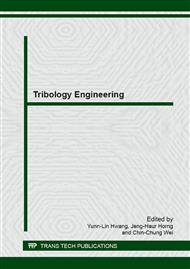p.184
p.190
p.196
p.202
p.207
p.212
p.217
p.222
p.227
Feasibility Study of Micro-Hole Wall Grinding by Micro-Elastic Abrasive Particles
Abstract:
This study aims to develop a polishing process improvement technology for deep micro-hole knockout hole wall with high aspect ratio, and discuss the optimal polishing parameter combination of abrasive jet machining method and micro-elastic abrasive particles for deep micro-hole knockout hole wall surface. A micro-elastic abrasive process technology was thus developed. The experimental results showed that the micro-elastic abrasive has better grinding effect on the surface roughness of knockout hole wall in length of 300 mm and in inside diameter of ψ2mm in the machining conditions of jet pressure 0.5MPa, volume mixing ratio 2:1 of abrasive particles to additive and vacuum attraction 70 cmHg. It was improved from 2.39 μm Ra (10.74 μm Rmax) to 0.08 μmRa (1.12 μm Rmax), proving the feasibility of micro-elastic abrasive. The surface was improved well, and the process time was shortened greatly.
Info:
Periodical:
Pages:
207-211
Citation:
Online since:
April 2015
Authors:
Keywords:
Price:
Сopyright:
© 2015 Trans Tech Publications Ltd. All Rights Reserved
Share:
Citation:


